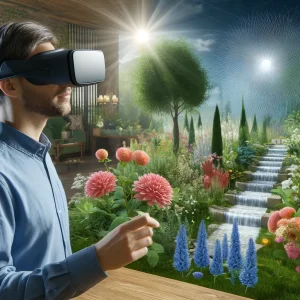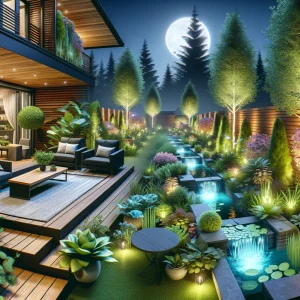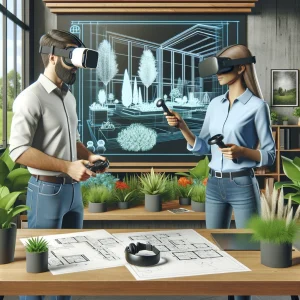Virtual Reality (VR) is no longer a futuristic concept reserved for gaming and entertainment. Today, it’s revolutionizing various industries, including landscape design. For landscapers and gardeners in British Columbia, offering clients a virtual reality walkthrough of proposed landscape designs is a game-changer. This technology allows clients to experience and approve designs before implementation, ensuring satisfaction and precision.

The Power of VR in Landscape Design
Virtual reality creates immersive 3D environments that clients can explore as if they were physically present. This technology enables landscapers to showcase their designs in a way that traditional blueprints and 2D drawings cannot match. Imagine walking your clients through a beautifully designed garden, allowing them to see how the flowers bloom, how the water features flow, and how the entire space feels at different times of the day.

Benefits of VR Landscape Design Walkthroughs
- Enhanced Visualization: Clients often struggle to visualize 2D plans and static images. VR eliminates this challenge by providing a realistic and interactive experience. Clients can explore every nook and cranny of the proposed design, making it easier to understand and appreciate the vision.
- Improved Client Satisfaction: With VR, clients can make informed decisions about their landscape design. They can instantly request changes and see the impact, leading to higher satisfaction and fewer revisions during the implementation.
- Efficient Communication: VR is a powerful communication tool between landscapers and clients. It bridges the gap between technical jargon and layperson’s terms, ensuring that both parties agree.
- Competitive Edge: Offering VR walkthroughs sets landscapers apart from their competitors. It showcases a commitment to innovation and customer satisfaction, attracting more clients and setting a business apart in a crowded market.

Real-World Applications and Examples
Case Study 1: Transforming a Backyard in Vancouver A landscaping company in Vancouver used VR to help a client visualize their dream backyard. The VR walkthrough allowed the client to explore different layouts, plant selections, and lighting options. The client could virtually walk through their new garden, experience the ambiance of the water feature, and see how the evening lighting would enhance the space. This interactive experience led to a design the client loved and ultimately approved without hesitation.
Case Study 2: Designing Public Spaces in Victoria In Victoria, a garden design firm utilized VR to present a proposal for a public park. The local government and community members could virtually tour the park and see the planned play areas, picnic spots, and green spaces. This immersive experience generated excitement and support for the project, leading to swift approval and funding.

Tools and Software for VR Landscape Design
Several VR tools and software are available for landscapers looking to incorporate this technology into their workflow. Some popular options include:
- SketchUp Viewer: Designers can create detailed 3D models and present them in VR.
- Twinmotion: A real-time 3D immersion software that offers VR compatibility and is known for its user-friendly interface.
- Lumion: Provides high-quality rendering and VR capabilities, making it easy to create lifelike landscapes.
Overcoming Challenges
While VR offers many benefits, it also comes with challenges. The initial cost of VR equipment and software can be high, and a learning curve is associated with using new technology. However, the investment pays off in the long run by enhancing client satisfaction and streamlining the design approval process.
Moreover, not all clients may be familiar or comfortable with VR technology. Clear instructions and support are essential to help them navigate the VR experience smoothly.

Getting Started with VR Landscape Design
For landscapers new to VR, here are some steps to get started:
- Invest in Quality Equipment: Purchase a reliable VR headset and compatible software. Consider starting with user-friendly tools like SketchUp Viewer or Twinmotion.
- Learn the Basics: Take online courses or attend workshops to learn how to create and present VR landscape designs. Many software providers offer tutorials and customer support to help you get started.
- Showcase Your Work: Use VR to develop a portfolio of past projects. To demonstrate the value of this technology, offer potential clients free VR consultations.
- Stay Updated: VR technology is rapidly evolving. Stay informed about the latest advancements and continually upgrade your skills and tools.
Virtual reality is transforming the landscape design industry in British Columbia. By offering VR walkthroughs, landscapers and gardeners can provide clients with an immersive and interactive experience, leading to higher satisfaction and more successful projects. Embrace this innovative technology to stay ahead of the competition and bring your landscape designs to life like never before.